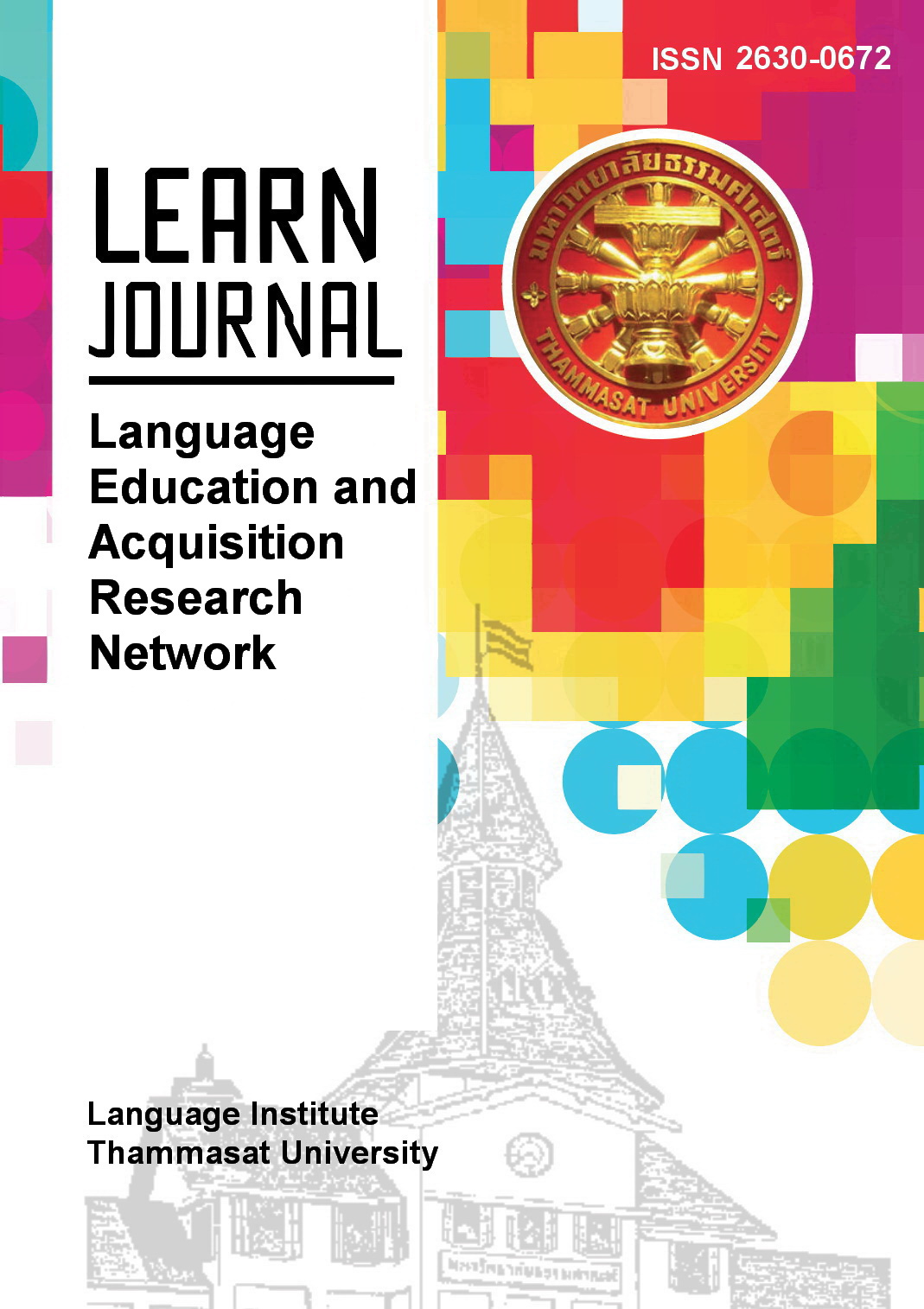Linguistics Study and Critical Thinking: Two Sides of the Same Coin?
Main Article Content
Abstract
From a linguistic perspective it seems intuitive that a strong link would exist between the study of linguistics and critical thinking (CT). After all, linguistics is about making sense of language analysis, which contributes to the enhancement of CT while CT, in reciprocation, enables meaningful analysis. Yet this link has virtually never been clearly defined or made explicit either in studies on linguistics teaching and learning or in those on CT development. This paper explores the relationship between linguistics study and CT in the Vietnamese context from the perspectives of undergraduate English Linguistics students and their lecturers, with a view to improving both students’ linguistics study and their CT. Drawing on data collected in questionnaires and interviews at a public university in Vietnam, the findings of the study reveal a variety of aspects of linguistics tasks and classroom activities where the link is significant as well as a range of specific CT skills and dispositions that are related to linguistics teaching and learning. In general, the students and the lecturers showed a positive attitude towards the integration of CT into linguistics teaching and learning, but challenges and barriers to this integration were identified. The study suggests the use of problem-solving tasks and open-ended questions for fostering the reciprocal relationship between linguistics study and CT.
Article Details
References
Anderson, C. (2016). Learning to think like linguists: A think-aloud study of novice phonology students. Language, 92(4), e274-e291. https://doi.org/10.1353/lan.2016.0081
Bauer, L. (2011). Teaching morphology. In K. Kuiper (Ed.), Teaching linguistics: Reflections on practice (pp. 27-34). Equinox.
Braun, V., & Clarke, V. (2006). Using thematic analysis in psychology. Qualitative research in psychology, 3(2), 77-101. https://doi.org/10.1191/1478088706qp063oa
Canada Institute of Linguistics. (n.d.). Why study linguistics. https://www.canil.ca/wordpress/about-canil/why-study-linguistics/
Carstairs-McCarthy, A. (2011). Learning phonology as a way to learn how theories are improved. In K. Kuiper (Ed.), Teaching linguistics: Reflections on practice (pp. 13-26). Equinox.
Chappell, P., & Moore, S. (2012). Novice teachers and linguistics: Foregrounding the functional. TESOL Quarterly, 46(3), 589-598. https://doi.org/10.1002/tesq.44
Chung, S. (2011). Teaching syntax. In K. Kuiper (Ed.), Teaching linguistics: Reflections on practice (pp. 35-39). Equinox.
Crystal, D. (2005). How language works. Penguin Books.
D'Amore, A. M. (2015). The role of translation in language teaching: Back to GT in ELT? In Y. Cui & W. Zhao (Eds.), Handbook of research on teaching methods in language translation and interpretation (pp. 118-135). IGI Global. https://doi.org/10.4018/978-1-4666-6615-3
Davies, M. (2015). A model of critical thinking in higher education. In M. B. Paulsen (Ed.), Higher education: Handbook of theory and research 30 (pp. 41-92). Springer International Publishing Switzerland. https://doi.org/10.1007/978-3-319-12835-1
Davies, M. (2022). Study skills for international postgraduates. Bloomsbury Academic. https://doi.org/10.1007/978-0-230-34553-9
Edge, J. (1988). Applying linguistics in English language teacher training for speakers of other languages. ELT Journal, 42(1), 9-13. https://doi.org/10.1093/elt/42.1.9
Elder, L., & Paul, R. (1998). The role of Socratic questioning in thinking, teaching, and learning. The Clearing House, 71(5), 297-301. https://doi.org/10.1080/00098659809602729
Elder, L., & Paul, R. (2016). The art of asking essential questions: Based on critical thinking concepts and Socratic principles. Rowman & Littlefield.
Ennis, R. H. (1989). Critical thinking and subject specificity: Clarification and needed research. Educational Researcher, 18(3), 4-10. https://doi.org/10.3102/0013189X018003004
Filimonova, V. (2020). Problem-based learning in introductory linguistics. Language, 96(1), e1-e21. https://doi.org/10.1353/lan.2020.0012
Fisher, A. (2011). Critical thinking: An introduction (2nd ed.). Cambridge University Press.
Floyd, C. B. (2011). Critical thinking in a second language. Higher Education Research and Development, 30(3), 289-302. https://doi.org/10.1080/07294360.2010.501076
Fromkin, V., Rodman, R., Hyams, N., Amberber, M., Cox, F., & Thornton, R. (2018). An introduction to language (9th ed.). Cengage Learning.
Gregory, H. (2015). Language and logics: An introduction to the logical foundations of language. Edinburgh University Press. https://doi.org/10.1515/9780748691647
Hadley, G., & Boon, A. (2023). Critical thinking. Routledge. https://doi.org/10.4324/9780429059865
Harris, R., & Taylor, T. J. (1997). Landmarks in linguistic thought 1: The Western tradition from Socrates to Saussure (2nd ed., Vol. 1). Routledge. https://doi.org/10.4324/9780203976975
Heard, J., Scoular, C., Duckworth, D., Ramalingam, D., & Teo, I. (2020). Critical thinking: Skill development framework. Australian Council for Educational Research. https://research.acer.edu.au/ar_misc/41
Kertész, A., & Rákosi, C. (2014). The evidential basis of linguistic argumentation. John Benjamins Publishing Company.
Kuiper, K. (2011). Teaching linguistics: Reflections on practice. Equinox
Linguistic Society of America. (n.d.). Studying linguistics. https://www.linguisticsociety.org/resource/studying-linguistics
Macaulay, M., & Syrett, K. (n.d.). Why major in linguistics? Linguistic Society of America. https://www.linguisticsociety.org/content/why-major-linguistics
McPeck, J. E. (1981). Critical thinking and education. Martin Robertson & Company Ltd.
Moore, S. H. (2007). Linguistics, applied linguistics and research: the axis of evil for language teachers? EA Journal, 23(2), 3-11.
Nguyen, T. M. T., & Nguyen, T. T. L. (2017). Influence of explicit higher-order thinking skills instruction on students’ learning of linguistics. Thinking Skills and Creativity, 26, 113-127. https://doi.org/10.1016/j.tsc.2017.10.004
Pappas, P. A., Taboada, M., & Alexander, K. (2019). Teaching linguistic argumentation through a writing-intensive approach. Language, 95(3), e339-e363. https://doi.org/10.1353/lan.2019.0062
Paul, R., Elder, L., & Bartell, T. (1997). California teacher preparation for instruction in critical thinking: Research findings and policy recommendations. California Commission on Teacher Credentialing.
Sharma, C. (1995). Linguistic factors in critical thinking: Developing thinking skills in the other tongue. Early Child Development and Care, 107(1), 35-43. https://doi.org/10.1080/0300443951070105
Stapleton, P. (2001). Assessing critical thinking in the writing of Japanese university students: Insights about assumptions and content familiarity. Written communication, 18(4), 506-548. https://doi.org/http://dx.doi.org/10.1177/0741088301018004004
Tatsumi, A. (2018). Teaching critical thinking in the language classroom. Cambridge. https://www.cambridge.org/elt/blog/2018/04/04/teaching-critical-thinking/
The Derek Bok Center for Teaching and Learning. (n.d.). Problem sets. Harvard University. https://bokcenter.harvard.edu/problem-sets
Wangdi, J., & Savski, K. (2022). Linguistic landscape, critical language awareness and critical thinking: promoting learner agency in discourses about language. Language Awareness, 1-22. https://doi.org/10.1080/09658416.2022.2115052
Welch, K., & Shappeck, M. (2020). Linguistics in general education: Expanding linguistics course offerings through core competency alignment. Languague, 96(2), e59-e75. https://doi.org/10.1353/lan.2020.0033
Yule, G. (2017). The study of language (6th ed.). Cambridge University Press. https://doi.org/10.1017/CBO9781316594131


